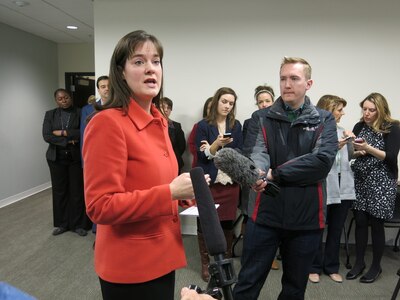Tennessee has been slow-walking its schools into online testing ever since a wholesale switch in 2016 went bust.
Now in its third year of the TNReady era, the state will test more students digitally this spring than ever before. And partly because of the decision to scale up gradually, leaders are promising that things will be different this time.
All high schoolers will test online when TNReady’s three-week testing window opens on Monday. And about 40 percent of districts have opted to go digital for at least some of their students in grades 5-8, too. (See which districts here.)
Next year, all of those middle grades will test online, while third- and fourth-graders will stick with paper-and-pencil tests.
Education Commissioner Candice McQueen ordered the gradual transition last year after a statewide switch of every school failed miserably for TNReady’s debut, overloading the testing company’s computer servers and stopping the test in its tracks on the very first day. The failure eventually led to the cancellation of TNReady testing for grades 3-8 and the firing of North Carolina-based Measurement Inc. as Tennessee’s testing company.
"We know that regardless of how much preparation occurs, statewide testing is complex, with many moving parts."
Candice McQueen, Tennessee education commissioner
State officials said Thursday they are confident the new digital platform will work under heavy traffic, even as their new testing vendor, Questar, had headaches administering computer-based tests in New York on Wednesday. Some students there struggled to log on and submit their exam responses — issues that Questar leaders blamed on a separate company providing the computer infrastructure that hosts the tests.
Sara Gast, a spokeswoman for the Tennessee Department of Education, said the problems that occurred in New York should not happen in Tennessee.
Tennessee’s testing platform, known as Nextera, is built on multiple servers in multiple locations, so backups are in place if needed, she said. That wasn’t the case on the first day of testing in 2016 when students logged on to find cursors spinning and the test failing to load, eventually prompting McQueen to scrap the online assessment.
There are other changes, too.
“Nextera does not require continuous connectivity to a wireless network in order for students to work through the test,” Gast said. “This means it automatically stores students’ progress throughout their experience and is not constantly ‘pinging’ the network.”
Last spring, no significant hiccups occurred when 24 districts opted to test their high schoolers online. And last fall, high schoolers who are on non-traditional block schedules completed 120,000 online exams across 97 districts. In addition, students statewide have taken some 780,000 practice sessions this school year — not only allowing Questar and districts to fine-tune their technology but also helping students get comfortable with online testing and the types of questions they will see.
“We know that regardless of how much preparation occurs, statewide testing is complex, with many moving parts,” McQueen wrote to the state’s superintendents earlier this week.

Her three-page letter outlined her department’s strategy for providing “immediate support” if problems occur, including Questar’s call center, and daily webinars and text alerts for testing coordinators at individual schools.
“Questar will have support staff located strategically around the state so no district in Tennessee will be more than 90 minutes away from having on-the-ground assistance if needed,” said McQueen, adding that extra computer devices for testing can be loaned to any district that runs into problems.
TNReady is the state’s annual test to measure what students know and are able to do. It’s the lynchpin of Tennessee’s accountability system, with student growth scores incorporated into teacher evaluations and intervention strategies for low-performing schools.
Scores have been low since Tennessee switched to the new test and new academic standards, but state officials expect results to improve as students and educators become acclimated to both.

